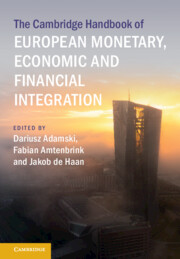Book contents
- The Cambridge Handbook of European Monetary, Economic and Financial Integration
- The Cambridge Handbook of European Monetary, Economic and Financial Integration
- Copyright page
- Contents
- Contributors
- Introduction
- Part I The Economic and Monetary Union
- Part II The Monetary Dimension
- Part III The Economic and Fiscal Dimensions
- 15 Reviving the Case for Policy Coordination in EMU
- 16 Ten Years of the European Semester
- 17 The EU Fiscal Rules
- 18 National Fiscal Policy in EMU
- 19 The Politics of Fiscal Integration in Eurozone Reforms and Next Generation EU
- 20 Adjustments in Economic Crises
- 21 Designing a Permanent EU-Wide Stabilization Facility
- 22 Enhancing Private and Public Risk Sharing
- Part IV Financial Integration
- Index
- References
21 - Designing a Permanent EU-Wide Stabilization Facility
from Part III - The Economic and Fiscal Dimensions
Published online by Cambridge University Press: 28 September 2023
- The Cambridge Handbook of European Monetary, Economic and Financial Integration
- The Cambridge Handbook of European Monetary, Economic and Financial Integration
- Copyright page
- Contents
- Contributors
- Introduction
- Part I The Economic and Monetary Union
- Part II The Monetary Dimension
- Part III The Economic and Fiscal Dimensions
- 15 Reviving the Case for Policy Coordination in EMU
- 16 Ten Years of the European Semester
- 17 The EU Fiscal Rules
- 18 National Fiscal Policy in EMU
- 19 The Politics of Fiscal Integration in Eurozone Reforms and Next Generation EU
- 20 Adjustments in Economic Crises
- 21 Designing a Permanent EU-Wide Stabilization Facility
- 22 Enhancing Private and Public Risk Sharing
- Part IV Financial Integration
- Index
- References
Summary
While the EU recovery plan provides a useful step in alleviating the economic effects of the COVID-19 crisis and achieving further European integration, a much-needed permanent fiscal stabilization capacity dealing with major crises is still missing. Such an EU-wide stabilization function would be in accordance with the subsidiarity principle, enshrined in the Treaty of Maastricht, as the risk-sharing that it provides can only be conducted at the supranational level. The chapter envisages a mechanism to semi-automatically respond to region- and country-specific shocks via a central fiscal stabilization fund (CFSF). A well-designed CFSF has the potential to improve welfare not only in crisis-hit member countries, but also in the union as a whole.
- Type
- Chapter
- Information
- Publisher: Cambridge University PressPrint publication year: 2023



